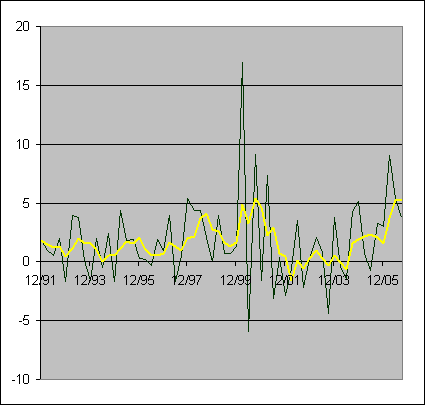Unit Labor Costs, one of the stats I view as critical in the analysis of inflation, came in higher than expected this morning: +3.8% vs. survey of 3.4%. Productivity was also below expectations: 0.0% vs. 1.0% surveyed. ULC for 2Q was also revised higher from 4.9% to 5.4%.
The bond market is mildly lower: down about 1/8. I'm surprised its not down more. My suspicion is that the bond bulls are focusing on the trend for ULC more so than the number itself. Witness the graph! The green line is the stat and the yellow is a four quarter moving average.
So while the 3Q ULC rise is well above the 15-year average of 1.74%, it has also decelerated two quarters in a row. Visually, it doesn't look like this is a figure that goes through short-term trends. In other words, it seems to accelerate one quarter then decelerate the other. In fact, only 26% of periods did the change in ULC show the same sign two quarters in a row.
The moving average is more telling. Note that the ULC is calculated on a quarterly basis and then annualized, so a four quarter moving average gives us a good full-year picture. The MA shows more apparent trends. During the deflation scare of 2001-2002, we did indeed see weak ULC figures. Today, we are obviously on an upswing. In fact, the MA is currently 5.30%, matched in this time series only by 5.35% in 3Q 2000.
If the dollars paid to laborers are rising at a 5.3% clip, the marginal propensity to consume is about 100% (i.e. consumers spend every additional dollar they earn), and output of consumer goods is growing below 5.3%, then consumer prices must increase. Even a monetarist such as myself can agree to this more Keynesian approach, because its simple math.
If you hold goods available for sale constant, but increase the dollars consumers have to spend, then the price of those goods must rise. It follows that if you increase the dollars consumers have to spend at a faster pace than output increases, then prices must rise.
Monetarists believe that inflation is always and everywhere a monetary phenomenon. But in real life, its tough to tell what the relevant money supply is. For example, if the Fed puts more money into circulation, but some foreign central bank decides to put an equal amount of dollars into a vault to maintain a currency peg, money available to the economy hasn't really changed at all. So we're forced to look at indicators of increasing money supply, such as rising labor costs.
In real life, my simple Keynesian math example gets a little complicated, because you have to consider availability of imports, which are fluid. But in my mind, as long as ULC is growing faster than 3% or so, core PCE will stay above the Fed's comfort zone. I can’t see the Fed cutting in this environment.
Thursday, November 02, 2006
A labor of love... and money
Subscribe to:
Post Comments (Atom)



2 comments:
I agree with the basic thrust of your post (wages go up -> inflation) but your example, as I am sure you know, gets more than a little complicated with spending on services (especially with the growing availability of imported services thanks to the internet).
BTW - with the massive popularity of consumer debt right now, have you considered the amusing possibility that people's MPC may be >100%? I know several people who got a pay raise and promptly bought something large on credit such that their repayments were equal to, and on one occasion greater than, their raise. But that's why I got in to behavioural economics at university rather than the hard stuff.
Richard
I think its clear that the MPC has been higher than 100% in the last 2-3 years. Whether its higher than that now, with no wealth effect from housing, we'll have to see. I suspect it will remain very close to 100% regardless.
Post a Comment